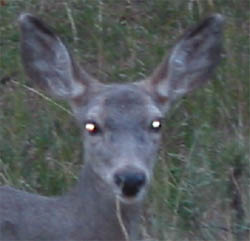
US Department of the Interior
Hi, this is Holly Strand for Stokes Nature Center located in beautiful Logan Canyon.
A few years ago, I was working for World Wildlife Fund in eastern Montana. One night, we were doing a nocturnal survey of the black footed ferret, the most endangered mammal species in North America. We were counting reintroduced ferrets by riding around in a truck with a large spotlight mounted on top. When the spotlight hit a ferret, we could see the emerald green glow of its eyes as the animal looked back at the light. We’d stop the truck, walk toward the green points, and confirm the presence of a curious ferret for our census count. If the glowing eye color was something other than green we kept on driving. It was during this nocturnal safari that I learned about animal eye-shine and how it can be used by hunters as well as naturalists in finding target species.
Eyeshine occurs when light enters the eye, passes through the rods and cones strikes a special membrane behind the retina, and is reflected back through the eye to the light source. This special mirror-like membrane, called the tapetum (ta-PEA-tum), is not present in the human eye. The light-capturing system allows light to pass through the eye twice, and it is one way a nocturnal animal increases its ability to see in dim light. It’s the tapetums cause the eerie glow that we see in a housecat’s eyes caught in a light or when our car headlights surprise a deer, or badger.
The color of eyeshine varies from species to species. Most owls have red eyeshine. Coyotes as well as mountain lion shine greenish-gold. Elk and deer – varies from silver white to a light silvery green or light silvery yellow. Desert cottontails’ are red. Tiny pricks of light may signify the presence of wolf spiders or moths. Even certain fish have eyeshine.
To see eyeshine in the wild, just take a walk on a relatively dark night, and hold a flashlight on top of your head so that you are looking down the beam. Direct the beam at bushes or low vegetation. Chances are, you’ll see the pink-tinted eyeshine of spiders. Near water, look for the greenish glow of frogs’ eyes. Keep the beam directed at the eyeshine and move closer until you can spot its owner. Bigger animals like deer or raccoons will be farther away so you may want to use binoculars in combination with a light, lining up the field of view with the light beam, and then moving the two in unison. Searching for eyeshine is the perfect summer night activity, so grab your flashlight and go out and experience some real Utah night life.
This is Holly Strand for Wild About Utah.
Credits:
Photo: Courtesy of National Park Service, US Department of the Interior Wind Cave Resource Ramblings 2007 – 11
Text: Stokes Nature Center: …
Sources & Additional Reading
2001, Corben, Chris and Gary Fellers. A Technique for Detecting Eyeshine of
Amphibians and Reptiles. Herpetological Review, 32(2): 89-91.
https://www.werc.usgs.gov/pt-reyes/pdfs/spotlighting.pdf
Eyeshine. Electronic Naturalist. Roger Tory Peterson Institute of Natural History. https://www.enaturalist.org/unit/171/qr (accessed June 2008)
Texas Parks and Wildlife. Eyeshine in Young Naturalist Series. https://www.tpwd.state.tx.us/publications/nonpwdpubs/young_naturalist/animals/eyeshine/ (accessed June 2008)
Thanks to Eric Gese, USDA National Wildlife Research Center, Department of Forest, Range, and Wildlife Sciences, for his expertise.
